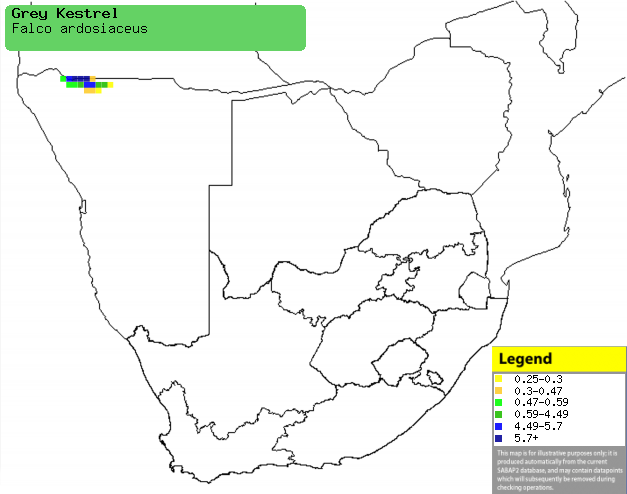|
Falco ardosiaceus (Grey kestrel)
Donker grysvalk [Afrikaans]; Donkergrysvalk [Afrikaans];
Grijze torenvalk [Dutch]; Faucon ardoisé [French]; Graufalke [German];
Falcão-cinzento [Portuguese]
Life
> Eukaryotes >
Opisthokonta
> Metazoa (animals) >
Bilateria >
Deuterostomia > Chordata >
Craniata > Vertebrata (vertebrates) > Gnathostomata (jawed
vertebrates) > Teleostomi (teleost fish) > Osteichthyes (bony fish) > Class:
Sarcopterygii (lobe-finned
fish) > Stegocephalia (terrestrial
vertebrates) > Tetrapoda
(four-legged vertebrates) > Reptiliomorpha > Amniota >
Reptilia (reptiles) >
Romeriida > Diapsida > Archosauromorpha > Archosauria >
Dinosauria
(dinosaurs) > Saurischia > Theropoda (bipedal predatory dinosaurs) >
Coelurosauria > Maniraptora > Aves
(birds) > Order: Falconiformes >
Family: Falconidae
Distribution and habitat
Occurs in sub-Saharan Africa from Senegal to Eritrea south
through Uganda, western Tanzania, southern and eastern DRC and Angola to the
extreme north of Namibia, specifically the Owambo and north-eastern Kunene
regions. It generally prefers open clearings in Northern lala palm (Hyphaene
petersiana), savanna and Mopane(Colosphermum mopane) woodland,
usually cleared by grazing and cultivation.
|
 |
|
Distribution of Grey kestrel in southern Africa,
based on statistical smoothing of the records from first SA Bird Atlas
Project (©
Animal Demography unit, University of
Cape Town; smoothing by Birgit Erni and Francesca Little). Colours range
from dark blue (most common) through to yellow (least common). |
Movements and migrations
Resident.
Food
It mainly eats insects and lizards, often hunting from a
perch and gliding to the ground to grab its prey; it may also
chase birds and bats aerially. The following food items have been recorded
in its diet:
- Animals
- insects
- lizards
- small birds
- bats
- rodents
- Husks of Hyphaene petersiana (Northern lala palm)
Breeding
- Little known in southern Africa, as only one nest has ever been recorded
in the region; it is however known to be a monogamous, territorial solitary
nester.
- The only nest ever found in Namibia was a cavity near the top of a dead
palm trunk.
- Egg-laying season is probably in early to mid September.
- It lays 3-5 eggs (recorded in Kenya), which incubated mostly by the
female for an estimated 30 days, while the male feeds her at the nest.
- The chicks stay in the nest for roughly four weeks.
Threats
Not threatened globally, in fact it appears to have benefited from
the clearing of dense woodland and forest, although its favoured Northern lala palm
savanna habitat is threatened by locals killing trees for their sap. It now has
an estimated Namibian population of 40 breeding pairs.
References
-
Hockey PAR, Dean WRJ and Ryan PG 2005. Roberts
- Birds of southern Africa, VIIth ed. The Trustees of the John Voelcker
Bird Book Fund, Cape Town.
|
